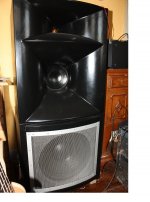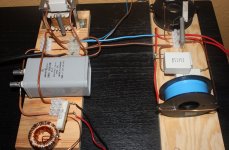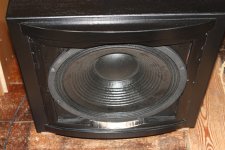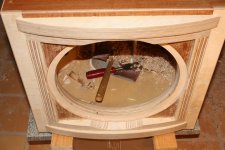FYI - Dave Wilson explains analog "Jitter" at 5:20
https://www.youtube.com/watch?v=r57gS75jiP4
Just another hi-fi buzzword to keep the customers interested.
He now spaces the crossover coils to prevent inductive coupling. What took him so long?
https://www.youtube.com/watch?v=r57gS75jiP4
Just another hi-fi buzzword to keep the customers interested.
He now spaces the crossover coils to prevent inductive coupling. What took him so long?
I'm sure they published papers on this, I recall a Smith chart that looked like a tight tight spiral... if I find it I'll let you know.
Your speaker is flat to 100kHz?? I think you mean 10kHz.
Mine is too... flat to past 10kHz. +/-less than yours... but as long as you achieve the results you wish, then I'm fine with it.
4Torr, imo, Mr. Wilson has jitter on his brain.
Your speaker is flat to 100kHz?? I think you mean 10kHz.
Mine is too... flat to past 10kHz. +/-less than yours... but as long as you achieve the results you wish, then I'm fine with it.
4Torr, imo, Mr. Wilson has jitter on his brain.
Perhaps.
What KEF models? I have seen quite a few KEF measurements, but none like that.
.
KEF - Wikipedia, the free encyclopedia
Described as Conjugate Load Matching.. from 1984. They also occasionally used T-lines with heavy line damping that would linearize impedance. I wouldn't say that any are as linear as your design.. BUT likely better than anything from Wilson Audio.
..and this is certainly a tangent well beyond the topic of this thread.
Last edited:
Hello folks,
I thought this would be a good forum to ask regarding what features make speakers sound "big", as though they are filling the room with sound. I have been listening to a few speakers at stores, from little satellite ones to bigger floor standing ones. Some of the small speakers sound "small", while other small ones sound "large".
Is it a matter of frequency response or equilization? Like the presence of low bass, or maybe a upper base hump somewhere due to room acoustics or speaker setup?
Or maybe the dispersion of the drivers, in how they spray sound everywhere and it bounces around?
Maybe cabinet resonance, or driver distortion that causes "good" harmonics?
Or perhaps the question to ask is what tricks does Bose use to make their little speakers sound big?
I think it is a little of everything:
-room design and room acoustic ( do you have reflections and interference or dont)
-how good are speakers ( phase and frequency linearity) Close they to ideal speaker better they convey the sound that was recorded in studio
-speaker design, how good is speaker body. It plays huge role in producing low frequency
You should have added " Anomalies "Everyone should be satisfied with the definition that I presented. It sounds scientific and as if explains everything.
"Some speakers produce euphonic big-speaker distortions that cause big sound perception ANOMALIES".
Last edited:
The top secret phase element is a resistor.I had lunch with Edgar before the Wilson interview and told him I had figured out how Wilson was doing it. I don't know if I should reveal it here, but I will say that it wastes a lot of power and flattens the electrical phase angle in a rather crude way. You may be able to figure it out from that...?
But, why isn't that resistor in parallel with an inductor, cap and an RC?
Yes, and it works well for midrange drivers too, to reduce/eliminate hard sound issues. If the speaker doesn't have a midrange, such as a 2-way speaker (or full range), you can use a sort of notch filter bypassed by a resistor (and sometimes also bypassed by an RC). That big filter is expensive and works mildy; however, generally worthwhile to reduce midrange hash/hardness (which is approximately on topic for this thread).is that not a trick aimed at compression tweeters ?
I have been using it for a few months now
the advantage was clearly heard on my bass guitar
pitch and tuning improved
But for bass guitar there's a different matter where current drive is useful (helps fit big woofer in small box). Sure a simple series resistor will probably make the big woofer want to run in the smaller box; however, Lenard Audio's Variable Current Drive (on their website) is an active way to do that same job, without wasting a lot of power into a resistor.
Also, check the feedback-shunt RC (groundside leg of the amplifier's gain divider). For example, chip amp datasheets have 1k with 22u, so 7.2hz*120= harmonic distortion for pitches below 864hz, and meanwhile back to the guitar; since the harmonic distortion gets progressively worse for lower pitches, by the time it gets down to 41hz, it probably won't sound like the correct note at all but rather a lot more like 82hz~164hz nondescript noise. If a bass booster is used on that, it would get a lot more boomy, masked and muddy, instead of more bass.
Fix:
However, 680u with 680R is 0.34hz*120=40.8hz and lower pitches distorted; however, your bass guitar's 41hz and higher pitches would all be clean. If a bass booster is used on that you'd get actually louder clean bass and no masking.
Info:
An even balance for H1/H2 occurs when the feedback RC is somewhere in the range of 0.25hz~4hz. All amplifiers are a little bit different, but if it was important to tune the bass guitar, then likewise it may be important to tune the amp. Reducing/eliminating bass distortion during amplification also reduces masking (also approximately on-topic for this thread).
Last edited:
In my experience - big sound can often be achieved with large baffles, nearly impossible without good low bass extension and can be helped by specific dispersion (not necessarily wide, but one that fits your room well etc.) and of course tweeter must be able to play all the details in upper octave where a large portion of "air" and "FX" are...
But it all may also be very room dependent...
For some reason - despite other significant advantages i find that waveguide speakers i made/listened are not very strong at imaging\soundstage and the most jaw-dropping soundstage, space and ambience i ever got was from large baffle MTM with powerfull bass...
But it all may also be very room dependent...
For some reason - despite other significant advantages i find that waveguide speakers i made/listened are not very strong at imaging\soundstage and the most jaw-dropping soundstage, space and ambience i ever got was from large baffle MTM with powerfull bass...
But for bass guitar there's a different matter ...
mine is a 3way
resistor is mounted on tweeter, but still have influence on tuning pitch
and you may also know the possible problems with noise
no effects or anything, just 'pitch clean' I think it's called
it was built as an experiment to try the different design principles
I was bit over enthusiastic, and the speaker got too heavy to move anywhere
so now I think of it more like a studio allround speaker
funny thing, and far more OT, but the crossover still turned out more less the same way I would have done for music/hifi

but somehow I can't help thinking how much the same things with pitch tuning etc also have influence on how a common hifi speaker reproduces music
Attachments
That's a beautiful speaker!funny thing, and far OT, but the crossover still turned out more less the same way I would have done for music/hifi
Yes, big woofer in small box, would be the same crossover for either hi-fi or bass guitar. However, "easy to carry" is more likely to be specified for bass guitar, thus current drive amplifiers are a bit popular for it.
Closed. Oh good! I actually find that closed and "stuffed port" tends to play at the right pitch. And I always assumed that ported was for portables to have more effective bass at the cost of more distortion.thanks
ehh, no not really small woofer box, as such
woofer is selected especially for smallish VAS for it's size
and box is closed and calculated for smooth rolloff
it is very clean
However, I did build one ported speaker with the black aluminum Dayton Reference woofers and it did indeed play at the right pitch without any of the headache inspiring blur common to ported speakers.
My one ported speaker is a 7" black aluminum plus a 2" paper, with a hybrid series crossover (in this case a really haywire looking mess). That speaker doesn't seem to do the port droning thing, but I attribute that to the woofer itself. Same model woofer as Statement Monitor. My implementation was cheaper and 2/3rds size (to fit existing cabinets--old cerwin vega 2-way). My LM3886 fainted repeatedly if exuberant playback was attempted. Found out afterwards that 4 ohm speakers need either parallel amplifiers or parallel output transistors, thus some new projects.
P.S.
Next shotgun wedding with the hybrid series thing, is a 12" DVC subwoofer mated to a 4" midrange, for a 1941 Crosley refit. That thing is open back and paper thin, so now I have to figure out the current drive thing for sure. Darnit!
Last edited:
In my experience - big sound can often be achieved with large baffles...
For some reason - despite other significant advantages i find that waveguide speakers i made/listened are not very strong at imaging\soundstage and the most jaw-dropping soundstage, space and ambience i ever got was from large baffle MTM with powerful bass...
I found the following post helpful in identifying what effect is occurring in large baffles (delayed reflections that are "coherent" with the direct source from the full-range driver cones):
http://www.diyaudio.com/forums/multi-way/177403-linkwitz-orions-beaten-behringer-what-32.html#post3403094
This also explains why many have trouble with "waveguide" (horn-loaded) loudspeakers: to achieve the same levels of delayed reflections as a OB-mounted full-range driver, the horn-loaded loudspeaker must be placed on a smooth room wall or corner, which no obstructions within 2-4 feet (0.6-1.3 metres) of the horn's mouth.
Personally, I prefer a "reflection-free zone" (RFZ, a term coined by Peter D'Antonio) around my midrange horns in order to enhance stereo phantom center channel imaging with my setup in two-channel mode. This way, I get to hear the acoustic depth of the original recording space without "depth enhancement".
Chris
- Status
- This old topic is closed. If you want to reopen this topic, contact a moderator using the "Report Post" button.
- Home
- Loudspeakers
- Multi-Way
- What gives speakers a "big sound"?



